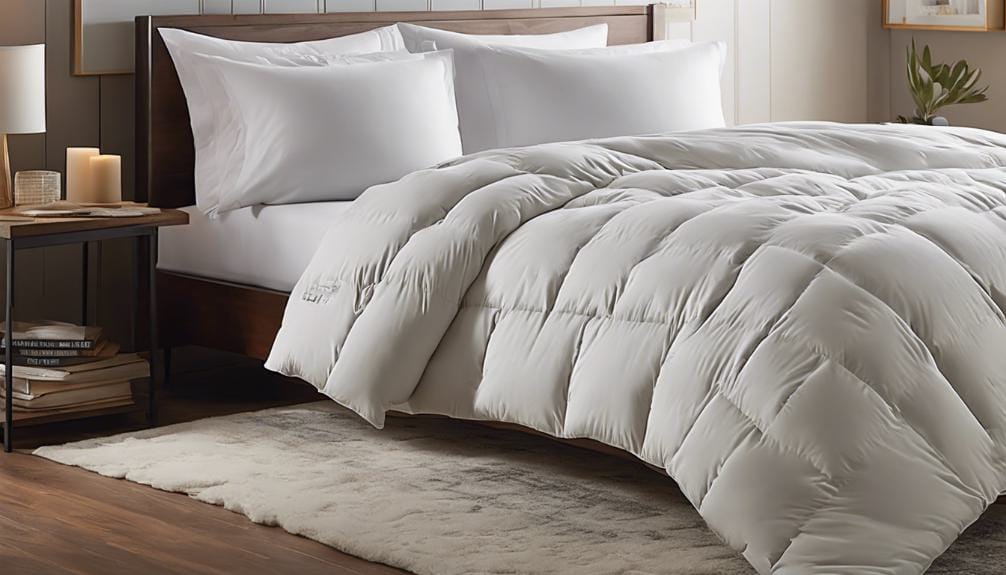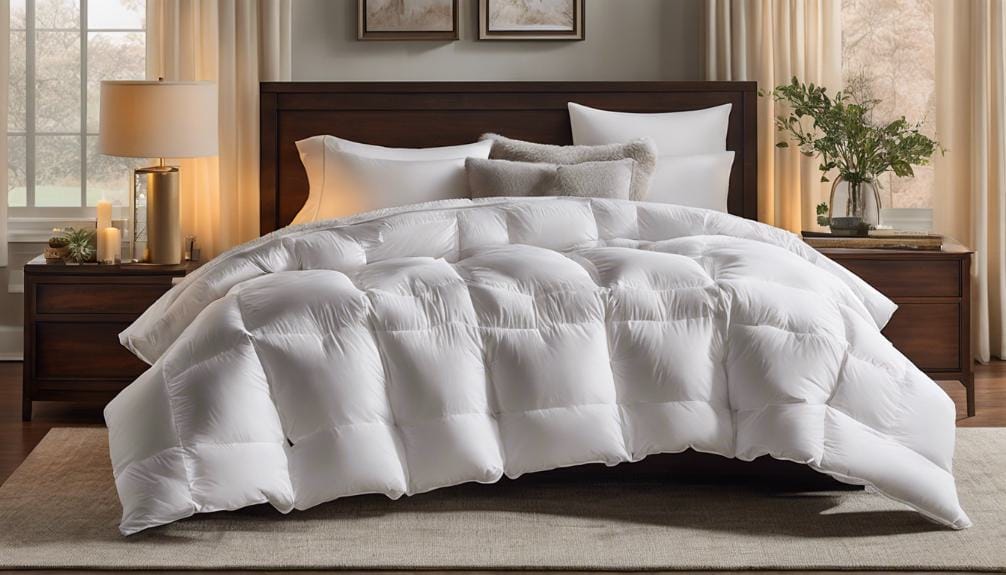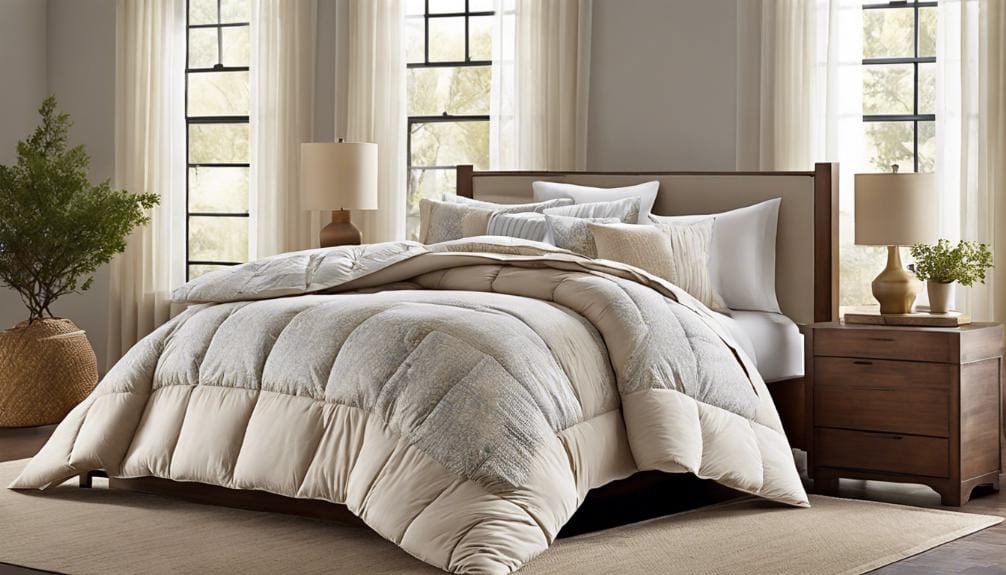How To Choose A Down Comforter: Expert Advice & Tips
When you are in the market for a down comforter, it’s vital to take into account several factors that can greatly influence your comfort and satisfaction. Start by evaluating the fill power and type of down that aligns with your climate and personal preferences, as these elements play a key role in warmth and durability. Additionally, the construction style can affect how well the comforter retains heat. As you navigate through these choices, you’ll find that comprehending your budget and size requirements is equally important. But what happens once you uncover the nuances that could make or break your decision?
What is Fill Power?

Fill power is an important factor when selecting a down comforter, as it directly impacts warmth and comfort. It measures the quality and loft of the down, indicating how well the comforter can trap air and provide insulation. Higher fill power, typically 600 and above, signifies larger and stronger down clusters that improve your comfort.
If you’re in a warm climate, you might find that a fill power between 500-600 suits your needs well. However, for colder environments, aim for 600-700 fill power for ideal warmth, or even 700+ for premium insulation. Additionally, considering ethical concerns related to down sourcing can influence your decision between natural and synthetic options.
The down type you choose also plays an important role in the comforter’s performance. Goose down is regarded as the premium option due to its hypoallergenic nature and superior warmth.
Additionally, the construction of the comforter matters; baffle box construction is ideal as it allows for more depth and loft compared to other styles. When considering warmth level, think about how you sleep and the climate of your bedroom.
Which Type of Down is Best?
When picking your down comforter, you’ll want to evaluate whether goose down or duck down is the better fit for you.
Goose down offers superior warmth and hypoallergenic properties, while duck down is typically more budget-friendly.
Also, think about the color; white down blends with fabrics better than grey down, but that won’t impact the comfort or quality.
Goose down is often sourced more ethically and provides longer-lasting performance.
Goose down vs Duck down
Choosing between goose down and duck down can greatly impact your comfort and warmth during sleep.
Goose down is often considered the premium choice. Its larger down clusters provide superior insulation and warmth level, making it ideal for colder climates. With a higher fill power, typically 600+, goose down comforters trap more air, offering better breathability and durability compared to their duck down counterparts. Additionally, goose down’s natural composition guarantees a superior warmth-to-weight ratio, enhancing overall sleeping comfort.
On the other hand, duck down is more affordable and can still offer decent insulation. However, duck down clusters are generally smaller, resulting in lower fill power and warmth level. If you sleep in a warm climate or prefer a lighter comforter, duck down might be suitable for you.
When choosing between the two, consider your budget and sleeping preferences. If you’re willing to invest in a long-lasting comforter, go for goose down.
However, if cost is a concern and you don’t mind sacrificing a bit of warmth and insulation, duck down can be a good alternative. Ultimately, weigh your needs against the advantages of each type to make the best choice for your sleep comfort.
Color considerations
Color can play a role in your choice of down comforter, though it doesn’t affect the comfort or quality of the insulation. When selecting a color, consider how it fits into your bedroom decor and personal style.
While the down type and fill power are the main factors influencing warmth level, the color can improve the overall aesthetic of your space. If you’re opting for goose down, which is known for its superior warmth and hypoallergenic properties, you might prefer lighter colors like white or cream. These shades blend well with various fabrics and can create a cozy, inviting atmosphere.
However, if you choose duck down, darker colors can help mask any potential discoloration over time.
The construction of the comforter also plays a role in its appearance. Baffle box construction, for example, allows for better loft and can showcase the down’s fluffiness, regardless of color.
Ultimately, while warmth level and down type should be your top priorities, choosing a color that complements your room can make your comforter a beautiful addition to your bedding ensemble.
How to Assess Warmth Level?

When choosing a down comforter, think about how warm you sleep and the climate in your bedroom.
If you tend to get hot at night, a lightweight comforter might be best, while winter weight options are ideal for those who feel cold.
If you and your partner have different warmth needs, consider a dual warmth comforter to keep both of you comfortable.
Lightweight vs Winter weight
Evaluating the warmth level of a down comforter is essential for ensuring a comfortable night’s sleep. When deciding between lightweight comforters and winter weight options, consider your personal comfort and the climate you live in.
Lightweight comforters are perfect if you tend to sleep warm or reside in a mild climate. They provide just enough insulation without overheating, often featuring a lower fill power and less down type.
On the other hand, winter weight comforters are designed for those who need extra warmth during colder months. These options typically have a higher fill power, utilizing premium down types like goose down for superior insulation. If you often feel cold at night or live in an area with harsh winters, a winter weight comforter is your best bet.
To assess which option suits you best, think about how you sleep and the conditions of your bedroom. Remember, the right comforter should balance your warmth level with your comfort preferences, ensuring you stay cozy without feeling stifled.
Ultimately, choosing between lightweight and winter weight is about finding what aligns with your sleep habits and environmental needs.
Dual warmth options
For couples with differing warmth preferences, dual warmth options can be an ideal solution. A dual warmth comforter allows each partner to enjoy their preferred warmth level without compromise.
These comforters are typically designed with varying fill power on each side, accommodating different sleep styles. For example, one side may use higher fill power down for extra warmth while the other features a lighter down type for those who sleep hot.
When evaluating warmth level, consider the climate you live in and your individual heat preferences. If you’re a cold sleeper, look for a comforter with premium goose down and baffle box construction, which improves loft and insulation. This construction method prevents the fill from shifting, ensuring consistent warmth.
If your partner tends to overheat, opt for a lighter fill power or a blend of down types that offer breathability.
Pay close attention to the specifications, as a quality dual warmth comforter can provide the best of both worlds. With the right selection, you’ll create a cozy, personalized sleeping environment that meets both your needs.
What Construction Should I Look For?
When choosing a down comforter, pay attention to the construction type, as it affects both comfort and performance.
Baffle box construction is the best option for maintaining loft and warmth, while other types like ring stitch and European bag may not provide the same benefits.
Comprehending these differences will help you make an informed choice for your sleep needs.
Baffle box construction
Baffle box construction is a top choice for anyone seeking a down comforter that offers ideal warmth and comfort. This design features internal fabric walls that create individual compartments, allowing the down to loft fully and provide even insulation.
With baffle-box construction, you’ll experience better warmth retention, which is especially important if you sleep in a colder climate or prefer a higher warmth level.
When selecting your comforter, pay attention to fill power. A higher fill power indicates larger down clusters that provide superior insulation.
Opt for goose down if you want the best quality, as it offers excellent warmth and longevity.
It’s also essential to take into account your bed size; make sure you choose a comforter that fits well and drapes over the edges. A too-small comforter can leave you feeling chilly, while one that’s too large might overwhelm your bed.
Ultimately, baffle-box construction combined with the right fill power and down type can make a significant difference in your sleep experience.
Other construction types
While baffle box construction is a popular choice, there are other construction types to contemplate when choosing a down comforter. Each type has its pros and cons, which can affect the comforter’s performance regarding warmth level and durability.
One alternative is the ring stitch construction. It uses a series of small stitches to keep the down in place, but it may not provide the same loft and insulation as a baffle box. This can lead to cold spots, especially if you prefer a higher fill power for greater warmth.
Another option is the European bag construction, which features a sewn-through design. While it’s typically more affordable, it can compress the down, reducing its loft and overall effectiveness at retaining heat. If you’re in a colder climate, this mightn’t be the best choice for you.
Ultimately, your decision should consider your personal warmth level preferences and how the construction aligns with your needs.
Opt for a construction type that maintains the down’s loft for peak insulation, ensuring you stay cozy and comfortable throughout the night.
How Do I Choose the Right Size?

To choose the right size down comforter, start by measuring your bed to guarantee a proper fit.
You’ll want a comforter that closely matches your bed size, allowing for some drop over the sides.
Measuring your bed
How do you guarantee your down comforter fits perfectly on your bed? Start by measuring your bed accurately. Knowing the exact dimensions helps you choose a comforter that complements your bed size, making sure it drapes nicely over the edges. Here’s a simple table to guide you:
| Bed Size | Dimensions (inches) | Recommended Comforter Size (inches) |
|---|---|---|
| Twin | 38 x 75 | 66 x 86 |
| Full/Queen | 54 x 75 / 60 x 80 | 86 x 86 |
| King | 76 x 80 | 102 x 86 |
When measuring your bed, consider the height of your mattress as well. You’ll want your comforter to provide adequate coverage without being too short. Additionally, think about your budget; down comforters can vary in price based on fill power and quality. Higher fill power often means better insulation, but it also comes with a higher price. So, find a balance between your needs and your budget to guarantee you invest wisely in your comfort.
Options for bed sizes
Choosing the right size for your down comforter is essential for guaranteeing a comfortable night’s sleep. Start by measuring your bed size accurately. Most comforters come in standard sizes like twin, full, queen, and king.
When selecting a comforter, look for one that closely matches your bed dimensions, allowing for a little drop on the sides—this improves the overall aesthetic and keeps you warm at night.
Avoid choosing a “full/queen” comforter for a queen bed, as it may not provide adequate coverage. Pay attention to product specs and pros, especially if you’re considering different down types and fill power. Higher fill power indicates better insulation and warmth.
For instance, if you live in a colder climate or tend to sleep cold, opt for a comforter with a fill power of 700+, preferably made from goose down for maximum warmth.
Ultimately, choosing the right size and type of down comforter won’t only enhance your sleep experience but also guarantee that it lasts for years. Always consider your preferences and the climate when making your final decision.
What is My Budget?
When setting your budget for a down comforter, you’ll find prices range from $90 to $900, depending on quality and fill power.
Keep in mind that investing in a higher-quality comforter can offer long-term value, lasting 10-20 years with the right care.
Price range overview
A quality down comforter can be a significant investment, with prices typically ranging from $90 to $900. Your budget will largely dictate the quality and features you can expect. Generally, higher prices reflect superior fill power and down type, essential for warmth and longevity.
Here’s a quick overview of what you might find:
| Price Range | Fill Power | Down Type |
|---|---|---|
| $90 – $200 | 500 – 600 | Duck down |
| $200 – $400 | 600 – 700 | Goose down |
| $400 – $600 | 700 – 800 | Premium goose down |
| $600 – $900 | 800+ | Luxury goose down |
| $900+ | Custom fill | Specialty blends |
When setting your budget, consider what you prioritize most: do you want maximum warmth, a specific down type, or ideal fill power? Remember that investing in a higher-priced comforter can pay off in the long run, as quality products often last for years. Be sure to explore sales and discounts to get the best value for your budget!
Long-term value considerations
Investing in a quality down comforter can really pay off over time, especially if you take long-term value into account.
When setting your budget, consider that down comforters range from $90 to $900, depending on factors like fill power, down type, and size. Higher fill power—600 and above—means better insulation and durability, which can justify a higher price tag.
Goose down is typically more expensive but offers superior warmth and longevity compared to duck down. If you’re looking for the best long-term value, prioritize comforters with baffle box construction, as they maintain loft and warmth level more effectively over time.
Think about how you sleep; a lightweight comforter might suffice for warm climates, while those in colder areas should invest in heavier options.
Frequently Asked Questions
How Often Should I Clean My Down Comforter?
You should clean your down comforter every 6 to 12 months, depending on usage. Regular washing helps maintain its loft and insulation, keeping it fresh and extending its lifespan. Always follow the care instructions for best results.
Can I Use a Down Comforter Year-Round?
Yes, you can use a down comforter year-round. Choose a lightweight option for warmer months and a heavier one for colder seasons. Adjust based on your personal comfort and bedroom climate to guarantee a cozy sleep.
What’s the Best Way to Store a Down Comforter?
To store your down comforter, make sure it’s clean and dry. Use a breathable cotton bag or a large pillowcase. Avoid plastic, as it traps moisture, leading to mold or odors over time.
Are Down Alternatives Comparable in Quality?
Down alternatives can be comparable in quality, but they often lack the same breathability and insulation as down. If you’re sensitive to allergens or budget-conscious, they’re a good choice, but expect less warmth.
How Can I Tell if My Comforter Is Genuine Down?
To tell if your comforter’s genuine down, check for a label indicating down fill, feel for softness and loft, and try the “shake test.” Real down clusters expand and create a fluffy, cozy appearance.
In Conclusion
Choosing the right down comforter is all about comprehending your needs and preferences. Consider fill power, type of down, and construction to guarantee you stay warm and comfortable. Don’t forget to assess the size that fits your bed and keep your budget in mind. By taking these factors into account, you’ll find a comforter that not only improves your sleep but also complements your bedroom decor. Happy shopping for your perfect cozy companion!
